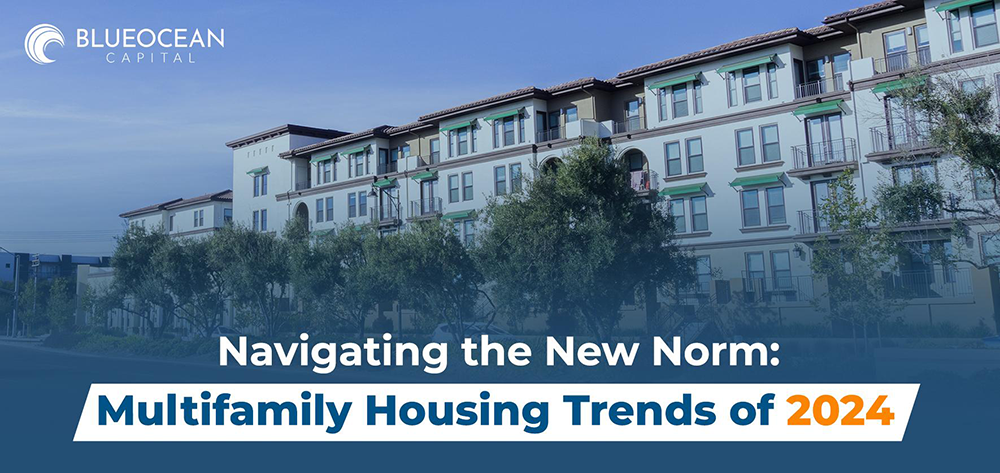|
Getting your Trinity Audio player ready...
|

By Dr. Chander Mishra
As we progress through 2024, the multifamily real estate sector continues to experience significant transformations, shaping a landscape brimming with both challenges and opportunities.
This detailed analysis delves into the seven pivotal trends that are not only redefining the multifamily market in the current year but are also expected to influence the sector well beyond 2024. Providing a comprehensive guide, this overview caters to investors and industry professionals aiming to navigate these evolving dynamics effectively.
article continues after advertisement
1. Historic Surge in Multifamily Construction
The year 2024 stands out for its record-breaking pace in multifamily construction, with the completion rates of new units reaching unprecedented levels. This boom is the result of a robust pipeline of projects initiated over the past few years. However, a recent deceleration in new construction starts—prompted by economic shifts, including interest rate adjustments—hints at a potential contraction in the pipeline by 2025. Currently, the market faces heightened competition as a flood of new properties enters the scene.
2. Rental Market Stabilization and Growth
Following a period marked by extreme volatility, the multifamily rental market is poised for stabilization. Predictions indicate a gradual increase in rental rates, fueled by a stable employment landscape, sustained housing demand, and ongoing economic uncertainties. The expected rent growth, while modest, suggests a market moving towards equilibrium, balancing out the rapid fluctuations experienced previously.
3. The Shift Towards Long-term Rentals
A significant trend reshaping the multifamily market is the growing preference for long-term rentals over homeownership. This shift is largely driven by the prohibitive mortgage rates and general unaffordability in the home-buying sector, which has broadened the demographic profile of renters to include those who might traditionally opt to buy. This demographic evolution offers real estate operators a chance to cater to a burgeoning market segment with specialized services and amenities aimed at long-term renters.
4. Impact of Hybrid Work Models

The adoption of hybrid work arrangements is significantly influencing multifamily housing preferences. As more people engage in remote or hybrid work, there’s an elevated demand for living spaces that accommodate home offices. Additionally, there’s a noticeable shift in preference towards multifamily locations further from conventional business districts. This shift provides an opportunity for real estate developers to innovate in property design and amenities, addressing the needs of a workforce that values flexibility and convenience.
5. Advancements in Property Search Technologies
The role of advanced technologies, particularly AI, in enhancing multifamily property searches is expected to expand in 2024. Building on the technological advancements of recent years, AI will increasingly influence how potential renters and buyers explore the property market, offering AI-powered search tools, virtual tours, and personalized recommendations. These technological advancements promise to make the property search process more efficient and tailored to individual preferences.
6. Emphasis on Environmental Sustainability

Environmental sustainability is becoming a critical factor in the multifamily real estate market. A growing segment of consumers is expressing a preference for eco-friendly housing options, including energy-efficient buildings, sustainable construction practices, and features that minimize the carbon footprint of residences. Real estate developers prioritizing sustainability are likely to appeal to environmentally conscious renters, aligning with broader societal shifts towards green living.
article continues after advertisement
7. Demographic Shifts Influencing Housing
Changes in demographics, such as the aging of certain populations and the emergence of millennial and Gen Z as significant groups of homebuyers and renters, are dictating evolving housing needs and preferences. These demographic trends necessitate a variety of housing solutions, from multi-generational living arrangements to affordable options for younger adults and accessible features for older residents.
Conclusion
The multifamily real estate market in 2024 is characterized by rapid evolution and diverse opportunities. For investors and industry stakeholders, staying informed about these trends is essential for navigating the complexities of the market and leveraging the potential it offers. As the sector continues to adapt and grow, the coming year promises to be a pivotal one for multifamily real estate, driven by innovation, consumer preferences, and economic factors.
Invest with Blueocean Capital
Our mission is to empower investors in building generational wealth and passive income, leaving a lasting legacy for their families. Through our comprehensive process of acquiring, operating, and eventually disposing of large-scale real estate assets, we offer a secure alternative to traditional stock and bond markets. Our unwavering commitment lies in safeguarding and preserving our investors’ wealth while delivering exceptional growth opportunities.
If you are interested in exploring the world of multifamily real estate investing and discovering how you can secure your financial future, we invite you to visit our website and schedule a call with us. Take the first step towards a brighter and more prosperous tomorrow with BlueOcean.



